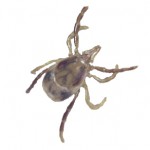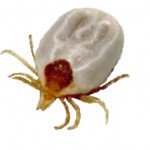Sponsored Post
There are approx 800 tick species worldwide with around 70+ of them found in Australia. All have been introduced to Australia with one exception, a deadly species that puts absolute fear into every pet owner in Eastern Australia. The “Ixodes Holocyclus” more commonly referred to as the “Australian Paralysis Tick”.
While the majority of reactions from tick bites are merely irritating; however if the bites are multiple it can provoke an intense allergic dermatitis (anaphylactic shock can be life threatening). Elsewhere in the world, Lyme disease from tick bite has a dramatic impact on human health. In Australia authorities still believe “there is no scientific evidence for Lyme disease in Australia”. Of the 800 tick species known worldwide only the “Australian Paralysis Tick” requires immediate medical or veterinary treatment. If treatment is not administered in the early stages, the result is often fatal.
There is a common misconception that ticks (and fleas) are only active during the warmer months in Australia. However there are a seemingly increased number of tick paralysis incident across the eastern states during the cooler months. Why is this? Some make claim a result of climate change allowing larvae to hatch all year round, while others say pet owners are simply more complacent with preventative measures throughout winter.
Regardless of the reason, the risk of your pet being affected by tick paralysis is very real and very life threatening. By coincidence at the time of writing this article, I actually discovered a Paralysis Tick on one of my own dogs – Amber! I check my dogs over on a daily basis and have never felt a tick before. I admit that if I ever did discover one, I expected it would be obvious to feel and see. The tick I found was an adult female (confirmed by the vet) however was very tiny; the size of a sesame seed and more white than grey. It was much smaller and paler to what I had in my mind.
As a result of finding the tick so early; it is thought only attaching the day before, Amber was one very lucky little girl and 48 hours later under observation did not develop any symptoms of paralysis – difficulty swallowing, drooling, change in bark, grunting noises, rapid breathing, wobbly legs etc.
What measures can you take to reduce your pet’s risk of becoming a host to an Australian Paralysis Tick?
1. Avoid Tick Habitats:
Do not walk your dog or allow your cat to wander in bush or scrub areas. Keep lawns and shrubs short and remove compost material and leaf matter from backyards.
2. Search Pets Every Day (or Twice Daily) For Ticks:
Always run your fingers through your dogs coat down to the skin. Not forgetting to check between pads of toes, groin, bottom, ears, and gums, under collars and around eyes/face. Try and become familiar with what an Australian Paralysis Tick or tick crater looks like!
3. Administer a Tick Control Product:
There are a number of products on the market. They range in application methods such as; sprayed directly onto the pets coat and skin, chewable tablets and simple pipette squeezed directly onto the skin of your pet’s neck or shoulder blades such as Frontline.
If you find a tick or a tick crater on your pet, regardless if you are using a tick preventative it is always recommended that you seek veterinary advice for further direction.
“This sponsored post was brought to you by Frontline.
If conditions persist, please seek advice from your local vet”.
Author Bio: Nikki is pack leader at Pressplay Pets, a blog for the modern age pet parent interested in health & care, news, reviews & personal accounts of unconditional love & at times heartfelt pain of pet parenting. She is also proud mum to cute and cheeky Papillons ‘Amber’ and ‘Indy’ and one crazy Rainbow Lorikeet named ‘Ralph’! Follow my Facebook and Twitter.
Pressplay Pets a blog for the modern age pet parent interested in health & care, news, reviews & personal accounts of unconditional love & at times heartfelt pain of pet parenting!
Follow Us!








Thanks for throwing importance for tick control treatment in winter. Awesome Article!